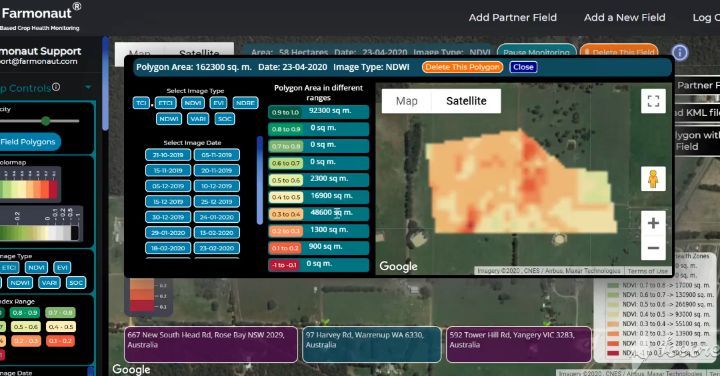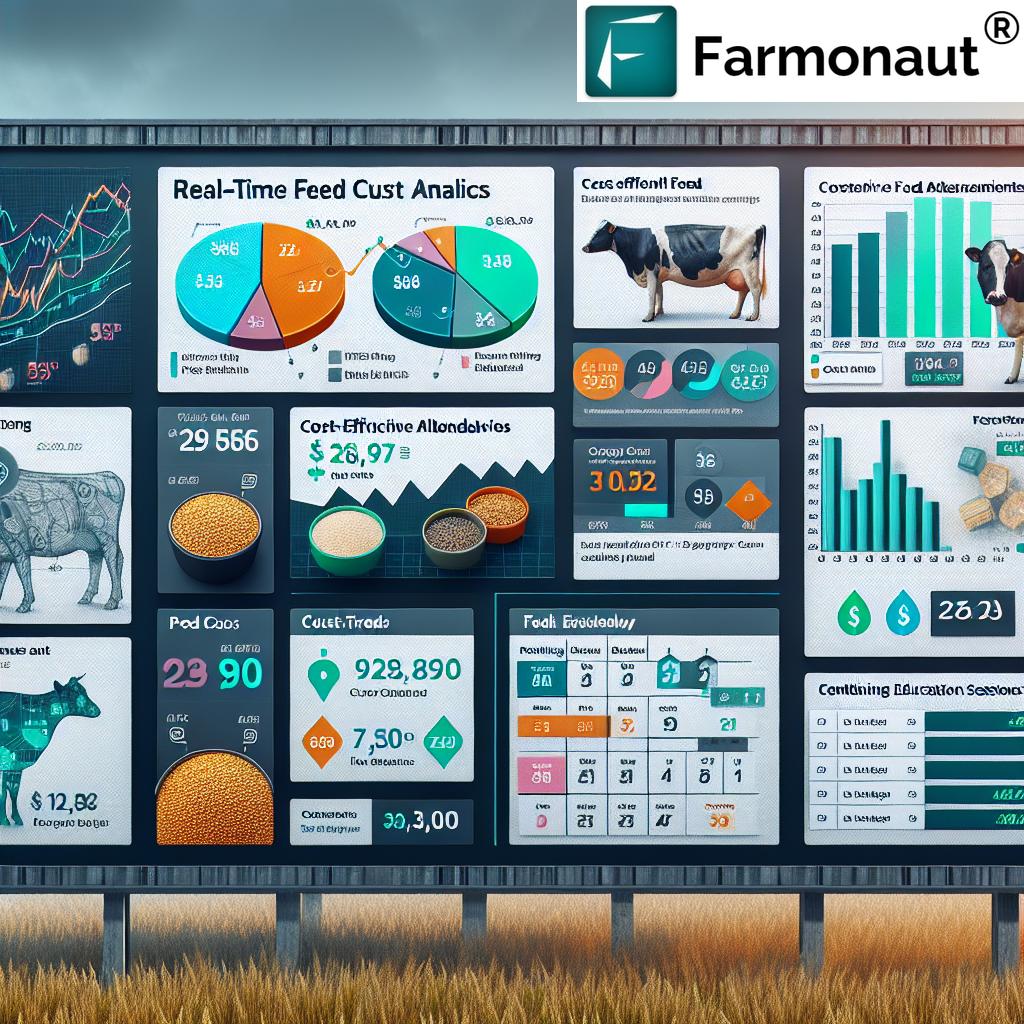Alternaria Blight in Crops: Identifying and Managing Late Blight for Optimal Yield

As agricultural experts and providers of cutting-edge farm management solutions, we at Farmonaut understand the critical importance of identifying and managing crop diseases effectively. Among the most devastating diseases that farmers face is Alternaria blight, also known as alternaria late blight. This comprehensive guide will delve deep into the intricacies of this disease, its impact on crops, and the most effective strategies for prevention and management.
Understanding Alternaria Blight
Alternaria blight is a fungal disease caused by various species of the Alternaria genus. It affects a wide range of crops, including potatoes, tomatoes, and other members of the Solanaceae family. The disease can occur at any stage of plant growth but is particularly damaging during the later stages of crop development, hence the term “late blight.”
Symptoms of Alternaria Blight
Recognizing the symptoms of alternaria blight is crucial for early detection and management. The most common signs include:
- Leaf lesions: Dark brown to black spots with concentric rings, often surrounded by a yellow halo
- Stem lesions: Dark, sunken areas on stems and petioles
- Fruit damage: Sunken, leathery spots on fruits, often near the stem end
- Defoliation: Severe infections can lead to extensive leaf loss
- Stunted growth: Plants may exhibit reduced vigor and growth

The Economic Impact of Alternaria Blight
Alternaria blight can have devastating consequences for farmers and the agricultural industry as a whole. The disease can lead to:
- Significant yield losses, often exceeding 50% in severe cases
- Reduced quality of harvested crops, affecting marketability
- Increased production costs due to the need for fungicide applications
- Long-term soil contamination, as the fungus can survive on plant debris
Given these potential impacts, it’s clear that effective management of alternaria blight is crucial for maintaining profitable and sustainable agricultural operations.
Factors Favoring Alternaria Blight Development
Understanding the conditions that promote the development and spread of alternaria blight is essential for implementing effective prevention strategies. The disease thrives under the following conditions:
- Temperature: Optimal temperatures range from 20°C to 28°C (68°F to 82°F)
- Humidity: High relative humidity (above 90%) favors spore germination and infection
- Leaf wetness: Prolonged periods of leaf wetness (12-18 hours) increase disease severity
- Plant stress: Stressed plants, due to drought, nutrient deficiencies, or other factors, are more susceptible
- Overcrowding: Dense plantings with poor air circulation create favorable microclimates for the disease
Advanced Detection Methods for Alternaria Blight
At Farmonaut, we leverage cutting-edge technology to provide early detection and monitoring of crop diseases, including alternaria blight. Our satellite-based crop health monitoring system offers several advantages:
Satellite Imagery Analysis
Our advanced satellite imagery analysis can detect subtle changes in crop health that may indicate the presence of alternaria blight before visible symptoms appear. This technology allows for:
- Large-scale monitoring of crop health across vast areas
- Regular updates on crop condition, allowing for timely interventions
- Detection of stress patterns that may indicate disease presence
Multispectral Imaging
Farmonaut’s multispectral imaging capabilities provide insights into various aspects of plant health, including:
- Vegetation health indices (e.g., NDVI) that can indicate plant stress
- Chlorophyll content analysis, which may reveal early signs of infection
- Leaf area index measurements to assess overall crop vigor
AI-Powered Disease Recognition
Our Jeevn AI Advisory System utilizes machine learning algorithms to:
- Analyze satellite imagery and identify potential disease hotspots
- Provide early warnings of disease outbreaks based on historical and real-time data
- Offer personalized recommendations for disease management
To access these advanced detection tools and more, visit our Farmonaut app or explore our API services for integration into your existing farm management systems.
Integrated Management Strategies for Alternaria Blight
Effective management of alternaria blight requires a multi-faceted approach that combines cultural practices, chemical controls, and advanced monitoring techniques. Here’s a comprehensive strategy for managing this devastating disease:
1. Cultural Practices
- Crop rotation: Implement a 3-4 year rotation with non-host crops to reduce inoculum buildup in the soil
- Sanitation: Remove and destroy infected plant debris to minimize overwintering of the pathogen
- Proper spacing: Ensure adequate plant spacing to improve air circulation and reduce humidity within the canopy
- Irrigation management: Use drip irrigation or water early in the day to minimize leaf wetness duration
- Nutrient management: Maintain balanced fertility to promote plant health and resistance
2. Resistant Varieties
Selecting disease-resistant cultivars is a crucial step in managing alternaria blight. While complete resistance is rare, many varieties exhibit partial resistance or tolerance to the disease. Consult with local agricultural extension services or seed suppliers to identify suitable resistant varieties for your region.
3. Chemical Control
Fungicide applications can be an effective tool in managing alternaria blight, especially when combined with other management practices. Consider the following when implementing a fungicide program:
- Begin applications at the first sign of disease or when environmental conditions favor infection
- Rotate between fungicides with different modes of action to prevent resistance development
- Apply fungicides at regular intervals, typically every 7-14 days, depending on disease pressure
- Use systemic fungicides for better protection during periods of rapid plant growth
Some effective fungicide active ingredients for alternaria blight control include:
- Azoxystrobin
- Chlorothalonil
- Difenoconazole
- Mancozeb
- Pyraclostrobin
Note: Always follow label instructions and local regulations when applying fungicides.
4. Biological Control
Incorporating biological control agents into your management strategy can provide additional protection against alternaria blight while promoting overall soil and plant health. Some beneficial microorganisms that have shown promise in managing the disease include:
- Trichoderma species
- Bacillus subtilis
- Pseudomonas fluorescens
These beneficial organisms can be applied as seed treatments, soil drenches, or foliar sprays to enhance plant resistance and compete with pathogenic fungi.
5. Advanced Monitoring and Forecasting
Utilizing Farmonaut’s advanced monitoring and forecasting tools can significantly improve the effectiveness of your alternaria blight management strategy. Our system provides:
- Real-time weather data and disease risk forecasts
- Early detection of crop stress that may indicate disease presence
- Customized alerts and recommendations based on your specific field conditions
By integrating these advanced technologies into your management approach, you can optimize fungicide applications, reduce unnecessary treatments, and improve overall disease control efficiency.
The Role of Precision Agriculture in Alternaria Blight Management
Precision agriculture techniques, powered by satellite technology and artificial intelligence, are revolutionizing the way farmers manage crop diseases like alternaria blight. At Farmonaut, we’re at the forefront of this agricultural revolution, providing farmers with the tools they need to make data-driven decisions and implement targeted management strategies.
Benefits of Farmonaut’s Satellite-Based Monitoring for Alternaria Blight Management
| Feature | Farmonaut Satellite System | Drone-Based Monitoring | IoT-Based Monitoring |
|---|---|---|---|
| Coverage Area | Large-scale (entire farms or regions) | Limited by flight time and regulations | Limited to sensor placement locations |
| Frequency of Updates | Regular (up to daily, depending on satellite availability) | As needed, but requires manual flights | Continuous, but limited to sensor locations |
| Cost-Effectiveness | High (no on-site equipment required) | Moderate (equipment and operator costs) | Variable (depends on number of sensors) |
| Data Analysis | Advanced AI and machine learning algorithms | Requires specialized software and expertise | Often limited to basic metrics |
| Integration with Weather Data | Seamless integration of satellite and weather data | Limited integration capabilities | Possible with additional sensors |
| Scalability | Highly scalable to any farm size | Limited by operational constraints | Requires additional investment for larger areas |
As demonstrated in the table above, Farmonaut’s satellite-based monitoring system offers numerous advantages over traditional drone and IoT-based solutions, particularly for large-scale alternaria blight management.
Implementing Precision Management with Farmonaut
To leverage the full potential of precision agriculture in managing alternaria blight, consider the following steps:
- Field Mapping: Use Farmonaut’s satellite imagery to create detailed field maps, identifying areas prone to disease development based on topography, soil moisture, and other factors.
- Vegetation Health Monitoring: Regularly monitor vegetation health indices to detect early signs of stress that may indicate disease presence.
- Weather Integration: Combine satellite data with localized weather forecasts to predict periods of high disease risk and optimize fungicide applications.
- Variable Rate Applications: Utilize zone-based management to apply fungicides and other inputs at variable rates, focusing on high-risk areas while minimizing unnecessary treatments.
- Performance Analysis: Track the effectiveness of your management strategies over time, using historical satellite data to identify trends and refine your approach.
By integrating these precision agriculture techniques into your alternaria blight management strategy, you can significantly improve disease control while optimizing resource use and minimizing environmental impact.
Future Perspectives in Alternaria Blight Management
As we look to the future of agriculture, several emerging technologies and approaches show promise for enhancing our ability to manage alternaria blight and other crop diseases:
1. Gene Editing and Resistant Crop Development
Advancements in gene editing technologies, such as CRISPR-Cas9, are opening new possibilities for developing crop varieties with enhanced resistance to alternaria blight. Researchers are working on identifying and modifying genes responsible for disease susceptibility, potentially leading to the creation of highly resistant cultivars.
2. Nanotechnology in Disease Management
Nanomaterials are being explored for their potential in improving fungicide efficacy and delivery. Nanoformulations of fungicides may offer benefits such as:
- Enhanced penetration and distribution within plant tissues
- Controlled release of active ingredients for prolonged protection
- Reduced environmental impact through lower application rates
3. Advanced Sensor Technologies
The development of new sensor technologies, including hyperspectral imaging and volatile organic compound (VOC) detectors, may enable even earlier detection of alternaria blight infections. These technologies could be integrated with satellite monitoring systems to provide more comprehensive disease surveillance.
4. Artificial Intelligence and Machine Learning
Continued advancements in AI and machine learning algorithms will enhance our ability to predict disease outbreaks, optimize management strategies, and automate decision-making processes. At Farmonaut, we’re continuously improving our AI-powered advisory systems to provide even more accurate and timely recommendations for alternaria blight management.
5. Blockchain for Traceability and Compliance
Blockchain technology has the potential to revolutionize disease management by enabling transparent tracking of crop treatments, fungicide applications, and disease incidence. This could lead to improved compliance with regulations and better coordination of regional disease management efforts.
Conclusion: A Holistic Approach to Alternaria Blight Management
Effective management of alternaria blight requires a comprehensive, integrated approach that combines traditional agricultural practices with cutting-edge technology. By leveraging Farmonaut’s advanced satellite monitoring and AI-powered advisory systems, farmers can gain unprecedented insights into their crop health and implement targeted management strategies.
As we continue to face challenges such as climate change and evolving pathogen populations, the importance of data-driven, precision agriculture approaches will only grow. By staying at the forefront of agricultural technology and implementing holistic management strategies, we can work together to minimize the impact of alternaria blight and ensure sustainable, productive farming systems for the future.
To learn more about how Farmonaut can help you manage alternaria blight and other crop health challenges, visit our website or download our mobile app:
For developers interested in integrating our satellite and weather data into their own applications, check out our API documentation.
FAQ: Alternaria Blight Management
Q1: How quickly can alternaria blight spread in a crop?
A1: Alternaria blight can spread rapidly under favorable conditions. In susceptible crops, the disease can progress from initial infection to widespread damage within 7-10 days if environmental conditions are conducive.
Q2: Can alternaria blight survive in the soil?
A2: Yes, the Alternaria fungus can survive in crop debris and soil for extended periods, sometimes up to two years. This is why proper sanitation and crop rotation are crucial management practices.
Q3: Are organic fungicides effective against alternaria blight?
A3: Some organic fungicides, such as copper-based products and biological control agents, can be effective against alternaria blight when used as part of an integrated management approach. However, they may require more frequent applications than synthetic fungicides.
Q4: How often should I monitor my crops for alternaria blight using Farmonaut’s system?
A4: With Farmonaut’s satellite monitoring system, you can receive updates on crop health as frequently as daily, depending on satellite availability. We recommend reviewing your crop health data at least weekly during the growing season, with more frequent checks during periods of high disease risk.
Q5: Can alternaria blight be completely eradicated from a field?
A5: Complete eradication of alternaria blight is challenging due to the pathogen’s ability to survive in soil and plant debris. However, through consistent implementation of integrated management practices and monitoring, the disease can be effectively controlled and its impact minimized.
Subscribe to Farmonaut
Ready to take your crop management to the next level? Subscribe to Farmonaut’s advanced satellite monitoring and advisory services:
By subscribing to Farmonaut, you’ll gain access to our full suite of precision agriculture tools, including real-time crop health monitoring, AI-powered advisory services, and customized alerts for alternaria blight and other crop health issues. Join the future of agriculture today!













